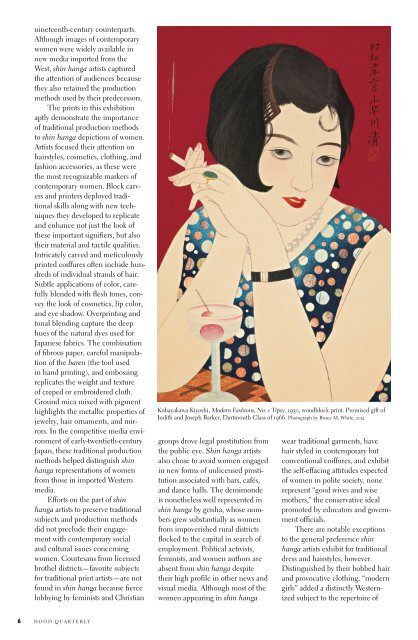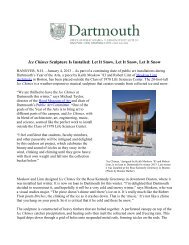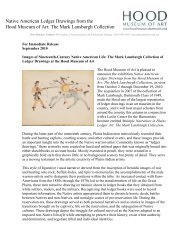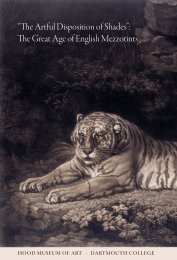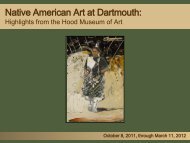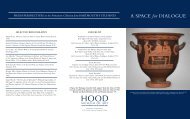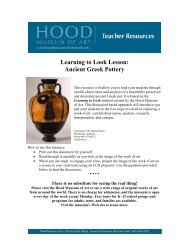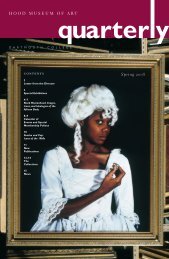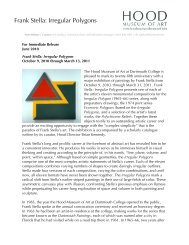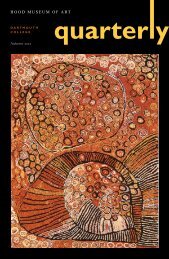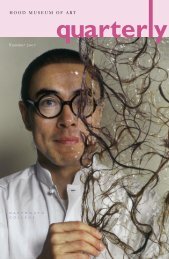Spring 2013 - Hood Museum of Art - Dartmouth College
Spring 2013 - Hood Museum of Art - Dartmouth College
Spring 2013 - Hood Museum of Art - Dartmouth College
- No tags were found...
Create successful ePaper yourself
Turn your PDF publications into a flip-book with our unique Google optimized e-Paper software.
nineteenth-century counterparts.<br />
Although images <strong>of</strong> contemporary<br />
women were widely available in<br />
new media imported from the<br />
West, shin hanga artists captured<br />
the attention <strong>of</strong> audiences because<br />
they also retained the production<br />
methods used by their predecessors.<br />
The prints in this exhibition<br />
aptly demonstrate the importance<br />
<strong>of</strong> traditional production methods<br />
to shin hanga depictions <strong>of</strong> women.<br />
<strong>Art</strong>ists focused their attention on<br />
hairstyles, cosmetics, clothing, and<br />
fashion accessories, as these were<br />
the most recognizable markers <strong>of</strong><br />
contemporary women. Block carvers<br />
and printers deployed traditional<br />
skills along with new techniques<br />
they developed to replicate<br />
and enhance not just the look <strong>of</strong><br />
these important signifiers, but also<br />
their material and tactile qualities.<br />
Intricately carved and meticulously<br />
printed coiffures <strong>of</strong>ten include hundreds<br />
<strong>of</strong> individual strands <strong>of</strong> hair.<br />
Subtle applications <strong>of</strong> color, carefully<br />
blended with flesh tones, convey<br />
the look <strong>of</strong> cosmetics, lip color,<br />
and eye shadow. Overprinting and<br />
tonal blending capture the deep<br />
hues <strong>of</strong> the natural dyes used for<br />
Japanese fabrics. The combination<br />
<strong>of</strong> fibrous paper, careful manipulation<br />
<strong>of</strong> the baren (the tool used<br />
in hand printing), and embossing<br />
replicates the weight and texture<br />
<strong>of</strong> creped or embroidered cloth.<br />
Ground mica mixed with pigment<br />
highlights the metallic properties <strong>of</strong><br />
jewelry, hair ornaments, and mirrors.<br />
In the competitive media environment<br />
<strong>of</strong> early-twentieth-century<br />
Japan, these traditional production<br />
methods helped distinguish shin<br />
hanga representations <strong>of</strong> women<br />
from those in imported Western<br />
media.<br />
Efforts on the part <strong>of</strong> shin<br />
hanga artists to preserve traditional<br />
subjects and production methods<br />
did not preclude their engagement<br />
with contemporary social<br />
and cultural issues concerning<br />
women. Courtesans from licensed<br />
brothel districts—favorite subjects<br />
for traditional print artists—are not<br />
found in shin hanga because fierce<br />
lobbying by feminists and Christian<br />
Kobayakawa Kiyoshi, Modern Fashions, No. 1 Tipsy, 1930, woodblock print. Promised gift <strong>of</strong><br />
Judith and Joseph Barker, <strong>Dartmouth</strong> Class <strong>of</strong> 1966. Photograph by Bruce M. White, 2012.<br />
groups drove legal prostitution from<br />
the public eye. Shin hanga artists<br />
also chose to avoid women engaged<br />
in new forms <strong>of</strong> unlicensed prostitution<br />
associated with bars, cafés,<br />
and dance halls. The demimonde<br />
is nonetheless well represented in<br />
shin hanga by geisha, whose numbers<br />
grew substantially as women<br />
from impoverished rural districts<br />
flocked to the capital in search <strong>of</strong><br />
employment. Political activists,<br />
feminists, and women authors are<br />
absent from shin hanga despite<br />
their high pr<strong>of</strong>ile in other news and<br />
visual media. Although most <strong>of</strong> the<br />
women appearing in shin hanga<br />
wear traditional garments, have<br />
hair styled in contemporary but<br />
conventional coiffures, and exhibit<br />
the self-effacing attitudes expected<br />
<strong>of</strong> women in polite society, none<br />
represent “good wives and wise<br />
mothers,” the conservative ideal<br />
promoted by educators and government<br />
<strong>of</strong>ficials.<br />
There are notable exceptions<br />
to the general preference shin<br />
hanga artists exhibit for traditional<br />
dress and hairstyles, however.<br />
Distinguished by their bobbed hair<br />
and provocative clothing, “modern<br />
girls” added a distinctly Westernized<br />
subject to the repertoire <strong>of</strong><br />
6 H O O D Q U A R T E R L Y


